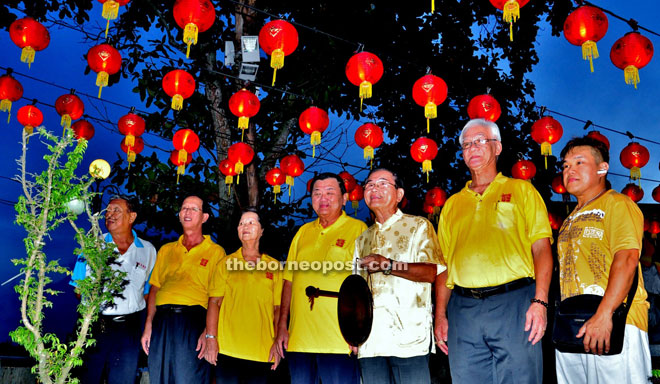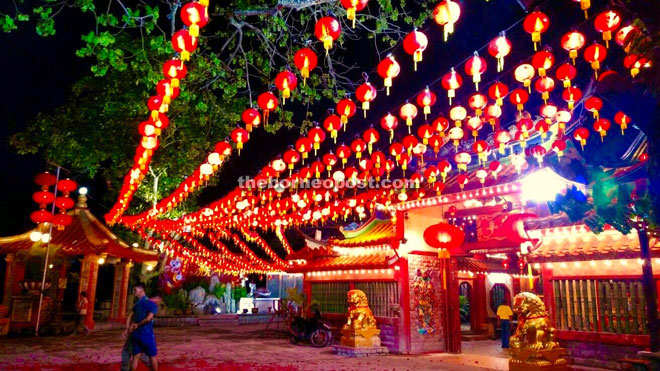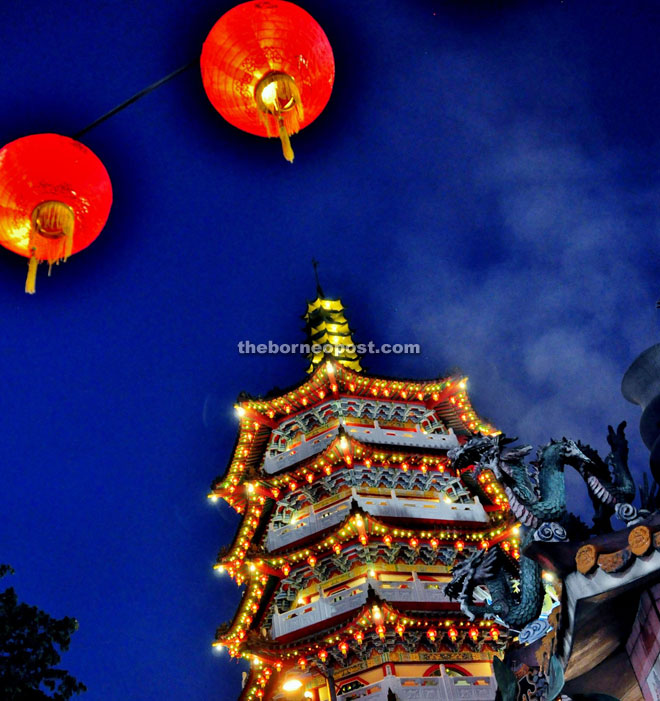
Soon (third right) beats the gong to symbolically switch on the red lanterns at Tua Pek Kong Temple.

The red lanterns hang over the main entrance of the temple.

Two red lanterns stand out in front of the pagoda.
SIBU: A total of 2,500 Chinese New Year lanterns were officially switched on as the Tua Pek Kong Temple here sent off Chinese deities to heaven on Monday night.
Known locally as ‘Balik Kampung’ as people working outstation rush home for Chinese New Year reunion, temple chairman Penghulu Soon Choon Hoo said according to folklore, the deities also ‘balik kampung’ for reunion with the heavenly host on the 24th day of the 12th month — a week before the Chinese New Year.
A ceremony was held at the temple on Monday led by Soon as they sent off the deities home.
Soon said: “We have traditionally set tonight to officially switch on the red lanterns to celebrate the double joy of the Chinese New Year and sending off the deities.”
He said they used to put up2,000 lanterns for the Chinese New Year, and to usher in the Year of the Fire Monkey this year, they had increased the number of lanterns.
The temple chairman said people traditionally sent off the deities in two days.
“In ancient China, the high ranking officials sent off the deities on the 23rd day; the common folk did so on the 24th day. We are passing on this tradition although we no longer divide the two days for the officials and the common folk separately. Worshippers can come at any of the two days for the ceremony.”
Soon said a common offering item in this occasion was the sticky Chinese New Year cake made of glutinous rice and brown sugar, so that when the deities returned to heaven, they would make good reports on the folk on earth with their candied mouths.
The temple chairman thanked worshippers for donating the lanterns for Chinese New Year celebration.
“Our practice is, each worshipper donates a lantern, and we contribute together to make this festival a family matter.”
He said after they switched on the lights on Monday, temple workers immediately went into spring cleaning. They also put on new clothes for the Tua Pek Kong deity.
Soon said the biggest celebration would begin on Chinese New Year Eve as thousands of people would throng the temple to pray, make offerings and ask for blessings.
“On the first day of the Chinese New Year, a string of festive activities await. We shall have lion and dragon dances starting at 7.30am, and a man dressed as the God of Fortune would give out angpows to children.”
He said the deity would symbolically return on the second day of the Chinese New Year, and the temple committee would receive Tua Pek Kong deity at 11am.
“The temple will be brightly lit until Chap Goh Meh – the fifteenth day of the festival. The 2,500 red lanterns in the temple compound will bring cultural goodwill in the blessings of luck and prosperity.”
